Auto Mac Speedup (Free Guide) - Removal Instructions
Auto Mac Speedup Removal Guide
What is Auto Mac Speedup?
Auto Mac Speedup – a misleading computer tool which appears on Mac OS X computers
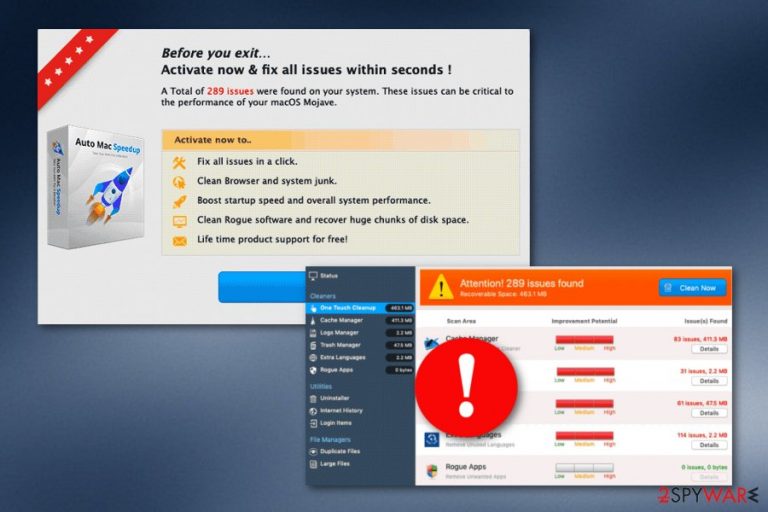
Auto Mac Speedup is a rogue computer cleaning program which users overcome on their Mac computers and laptops. The meaning of such software is to imitate full system scans and post warnings that numerous infections have been detected. However, all fake system optimizers do is collect outdated registry keys,[1] cache, and other similar content, and provide it as critical errors. Developers who spread Auto Mac Speedup virus seek to gain benefits from their customers as users are urged to purchase the license key to use the more elevated version of the system tool. We recommend staying away from this type of software as you should know that no respectable and truly reliable tool will sneak into your computer unnoticed, start displaying promoting pop-up notifications and try to scare you intentionally.
| Name | Auto Mac Speedup |
|---|---|
| Type | System tool |
| Sub-type | Scareware |
| OS | This rogue program often appears on Mac computers |
| Purpose | To gain income from users who agree to purchase the licensed version of the software |
| Detection | Use FortectIntego to detect all suspicious content |
| Elimination | Terminate the program by using specific tools or the step-by-step guide |
If you have encountered Auto Mac Speedup on your Mac, you should avoid using this software as it will not bring any benefits. Even though the program might claim that it is capable of dealing with various cyber infections, removing errors, optimizing the computer system, and so on, you need to know that it is only a promotion to attract a bigger number of people.
As you can see, Auto Mac Speedup is not a tool you can trust. Not only that this program sneaks into the system via bundling or unprotected websites, but it might also bombard your computer screen with intrusive notifications that promote the potentially unwanted application itself. Additionally, suspicious content might be added to your browser apps too.
You should also need to know that Auto Mac Speedup and similar tools are called scareware[2] not for no reason. The rogue program alerts about numerous errors and system issues found in order to scare the user and convince him/her to take fast actions. These actions are buying the licensed version of the program and paying the developers.
If you have been annoyed by pop-ups that have been caused by this rogue system tool, you should use anti-malware such as FortectIntego to locate the potentially unwanted program and all related content in the system. After that, remove Auto Mac Speedup virus from your Mac operating system by using automatical software or by performing our step-by-step guidelines.
The Auto Mac Speedup removal is necessary if you want to stop the annoying advertising and false warnings from showing up. Take notice that the potentially unwanted program might have planted some rogue content in your web browsers such as Google Chrome, Mozilla Firefox, Internet Explorer, so do not forget to check these applications too.
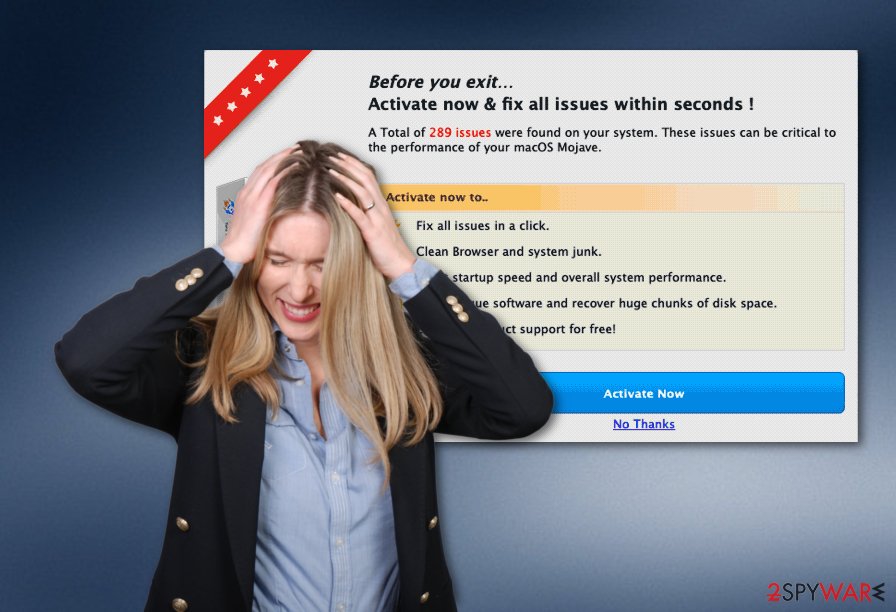
False applications are capable of sneaking into the system silently
According to SemVirus.pt[3] technology professionals, rogue applications are able to sneak into the computer by using stealth techniques. The most popular technique used by developers is bundling when the creators plant their apps into legitimate software packages which users download from third-party sources together with the PUP.[4]
Additionally, rogue programs and their components can be injected into misleading advertisements or hyperlinks that are found on secondary websites. Be careful with all content you access on the Internet sphere and make sure that you keep a distance from questionable-looking components to avoid possible unwanted software invasion.
Last but not least, download a reliable antivirus program. Every user should have automatical protection on their computer or laptop. The only two things you need to do is choose a reputable tool and make sure that it is always kept up-to-date. If not, the outdated version of the antivirus will not be able to protect your machine and the system properly anymore.
Auto Mac Speedup fake system tool can be removed by using two different techniques
Remove Auto Mac Speedup virus by using reputable software. Automatical computer tools are capable of eliminating the potentially unwanted program by using less effort and less time. However, if you feel self-confident enough to get rid of the cyber threat on your own, you can give a try to our step-by-step guide which is presented below the article.
Note that if you decide to perform the Auto Mac Speedup removal on your own, you risk making mistakes and causing even more damage to your computer system. Additionally, you will need to check all possibly-infected web browsers such as Google Chrome, Mozilla Firefox, Internet Explorer, Microsoft Edge, Safari, and others.
You may remove virus damage with a help of FortectIntego. SpyHunter 5Combo Cleaner and Malwarebytes are recommended to detect potentially unwanted programs and viruses with all their files and registry entries that are related to them.
Getting rid of Auto Mac Speedup. Follow these steps
Delete from macOS
If you have encountered the fake system optimization tool on your Mac computer system, you can get rid of it easily by performing these instructing steps:
Remove items from Applications folder:
- From the menu bar, select Go > Applications.
- In the Applications folder, look for all related entries.
- Click on the app and drag it to Trash (or right-click and pick Move to Trash)
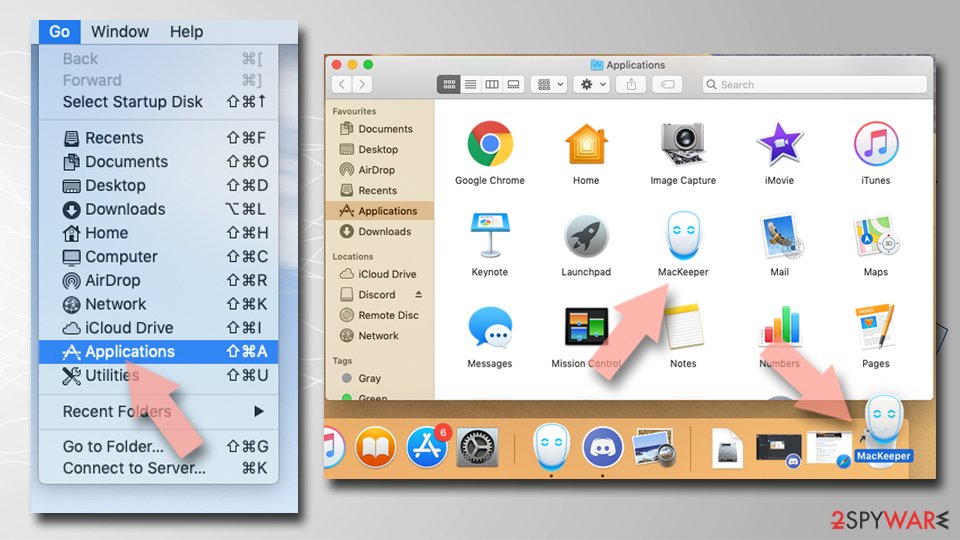
To fully remove an unwanted app, you need to access Application Support, LaunchAgents, and LaunchDaemons folders and delete relevant files:
- Select Go > Go to Folder.
- Enter /Library/Application Support and click Go or press Enter.
- In the Application Support folder, look for any dubious entries and then delete them.
- Now enter /Library/LaunchAgents and /Library/LaunchDaemons folders the same way and terminate all the related .plist files.
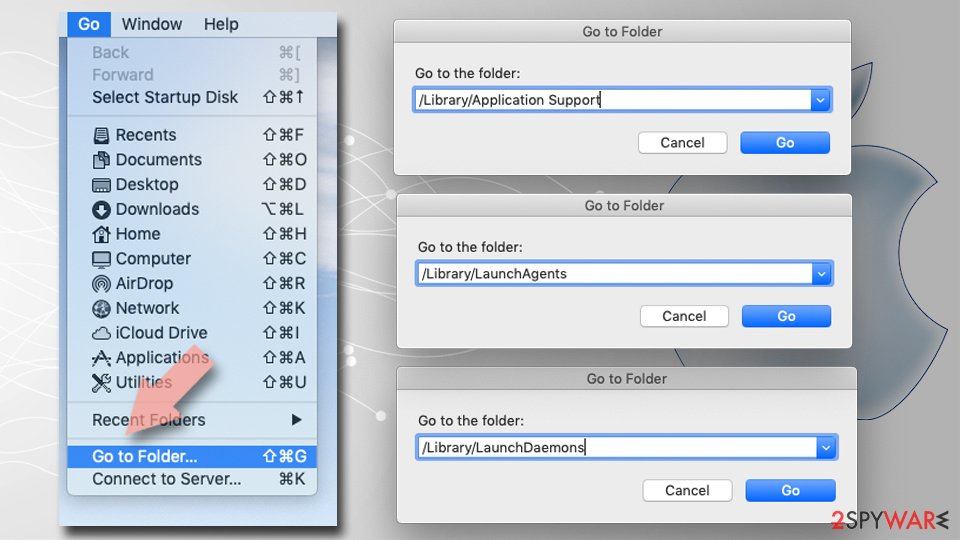
Remove from Microsoft Edge
Delete unwanted extensions from MS Edge:
- Select Menu (three horizontal dots at the top-right of the browser window) and pick Extensions.
- From the list, pick the extension and click on the Gear icon.
- Click on Uninstall at the bottom.
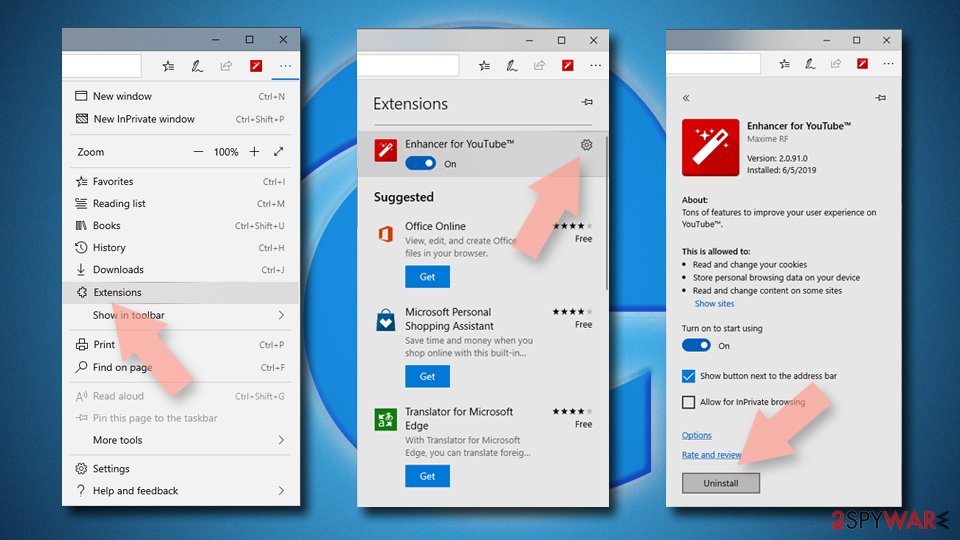
Clear cookies and other browser data:
- Click on the Menu (three horizontal dots at the top-right of the browser window) and select Privacy & security.
- Under Clear browsing data, pick Choose what to clear.
- Select everything (apart from passwords, although you might want to include Media licenses as well, if applicable) and click on Clear.
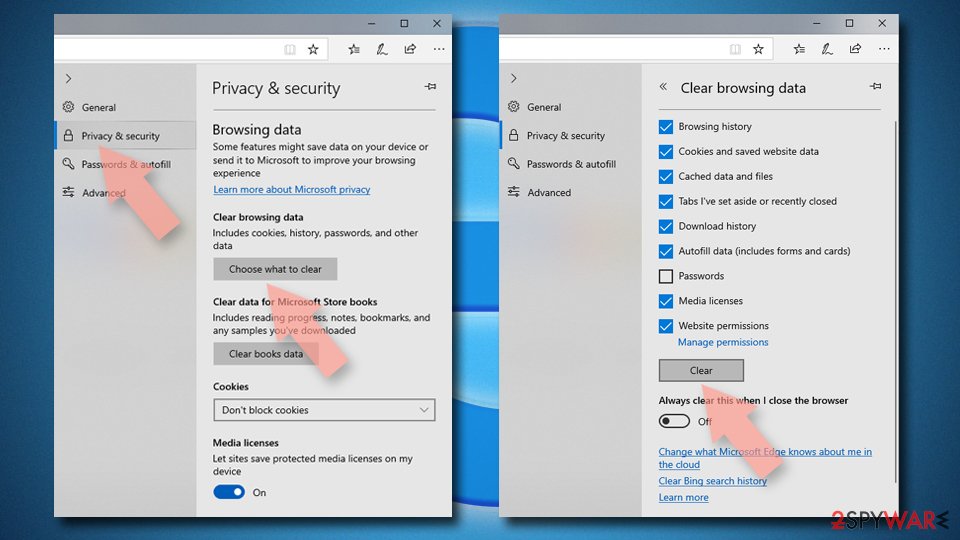
Restore new tab and homepage settings:
- Click the menu icon and choose Settings.
- Then find On startup section.
- Click Disable if you found any suspicious domain.
Reset MS Edge if the above steps did not work:
- Press on Ctrl + Shift + Esc to open Task Manager.
- Click on More details arrow at the bottom of the window.
- Select Details tab.
- Now scroll down and locate every entry with Microsoft Edge name in it. Right-click on each of them and select End Task to stop MS Edge from running.
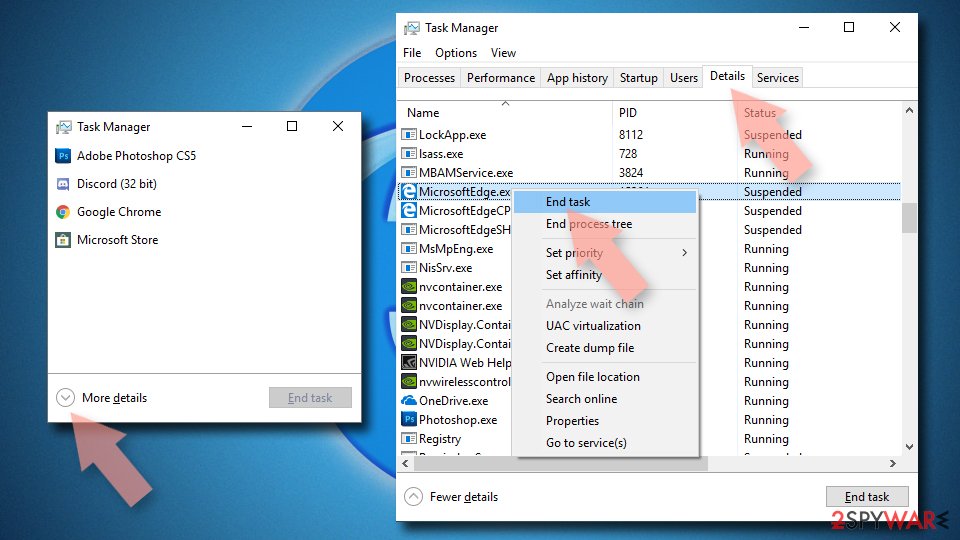
If this solution failed to help you, you need to use an advanced Edge reset method. Note that you need to backup your data before proceeding.
- Find the following folder on your computer: C:\\Users\\%username%\\AppData\\Local\\Packages\\Microsoft.MicrosoftEdge_8wekyb3d8bbwe.
- Press Ctrl + A on your keyboard to select all folders.
- Right-click on them and pick Delete
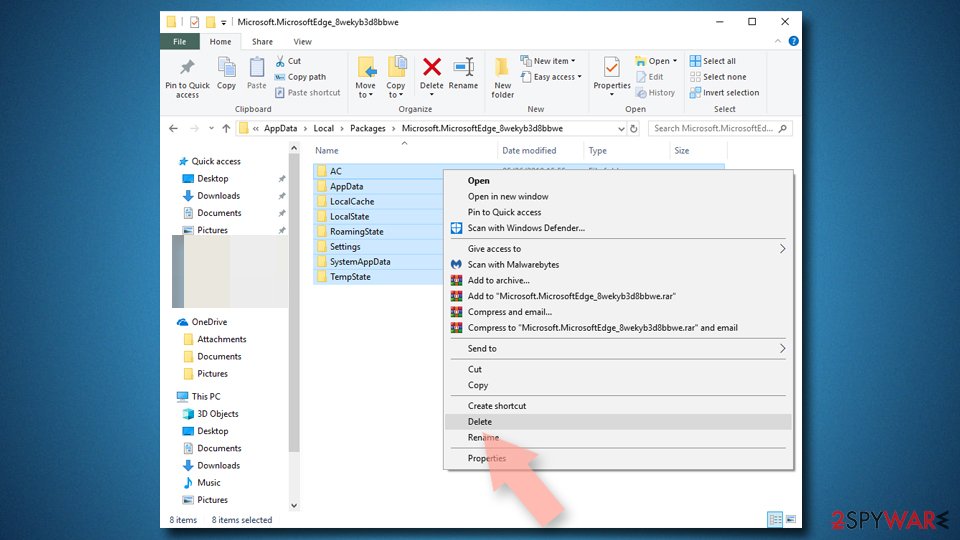
- Now right-click on the Start button and pick Windows PowerShell (Admin).
- When the new window opens, copy and paste the following command, and then press Enter:
Get-AppXPackage -AllUsers -Name Microsoft.MicrosoftEdge | Foreach {Add-AppxPackage -DisableDevelopmentMode -Register “$($_.InstallLocation)\\AppXManifest.xml” -Verbose
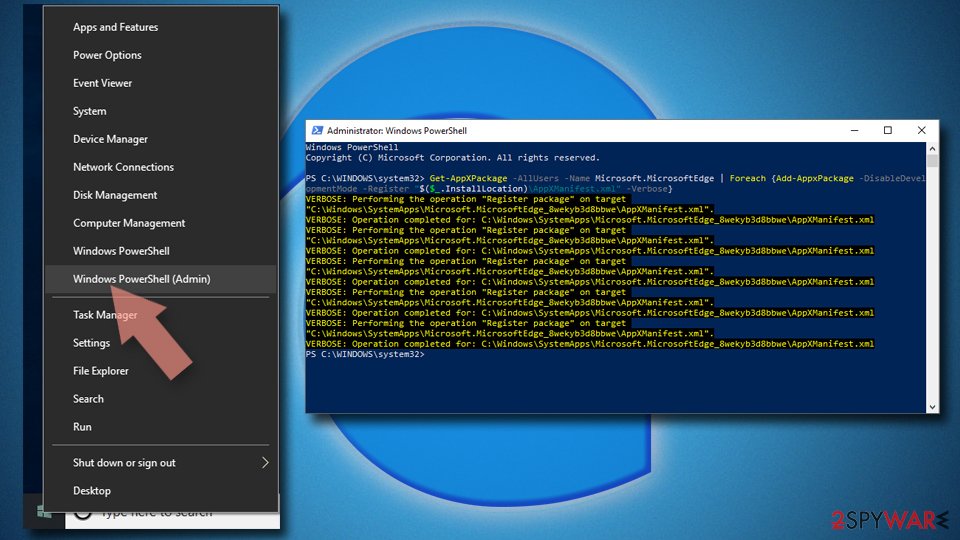
Instructions for Chromium-based Edge
Delete extensions from MS Edge (Chromium):
- Open Edge and click select Settings > Extensions.
- Delete unwanted extensions by clicking Remove.
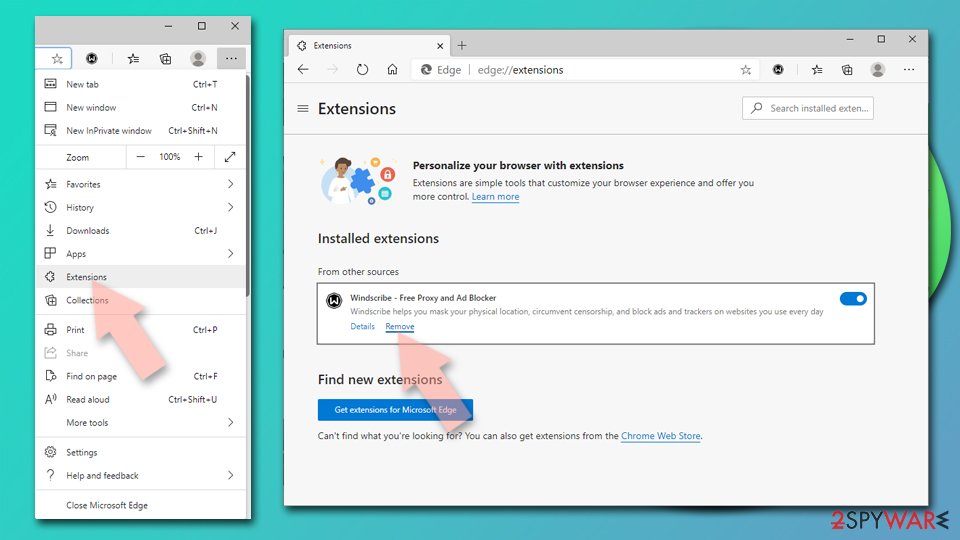
Clear cache and site data:
- Click on Menu and go to Settings.
- Select Privacy, search and services.
- Under Clear browsing data, pick Choose what to clear.
- Under Time range, pick All time.
- Select Clear now.
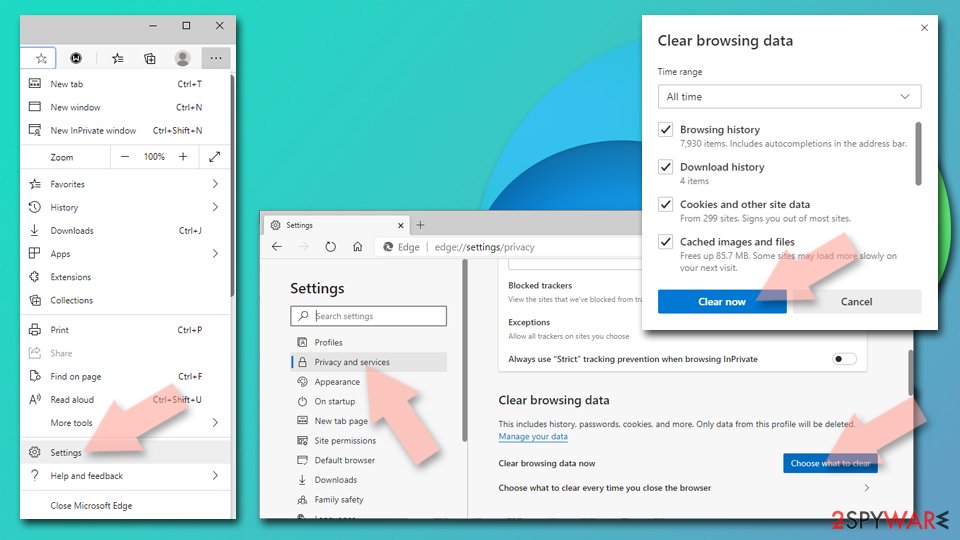
Reset Chromium-based MS Edge:
- Click on Menu and select Settings.
- On the left side, pick Reset settings.
- Select Restore settings to their default values.
- Confirm with Reset.
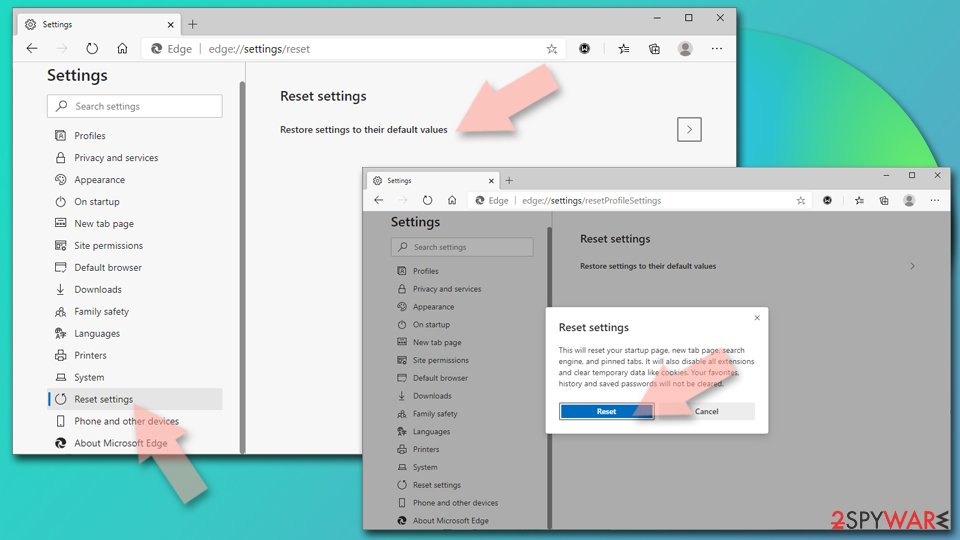
Remove from Mozilla Firefox (FF)
Spotting unknown objects in your Mozilla Firefox web browser is not a good thing. If you want to reverse all unpleasant changes, take a look at these instructions:
Remove dangerous extensions:
- Open Mozilla Firefox browser and click on the Menu (three horizontal lines at the top-right of the window).
- Select Add-ons.
- In here, select unwanted plugin and click Remove.
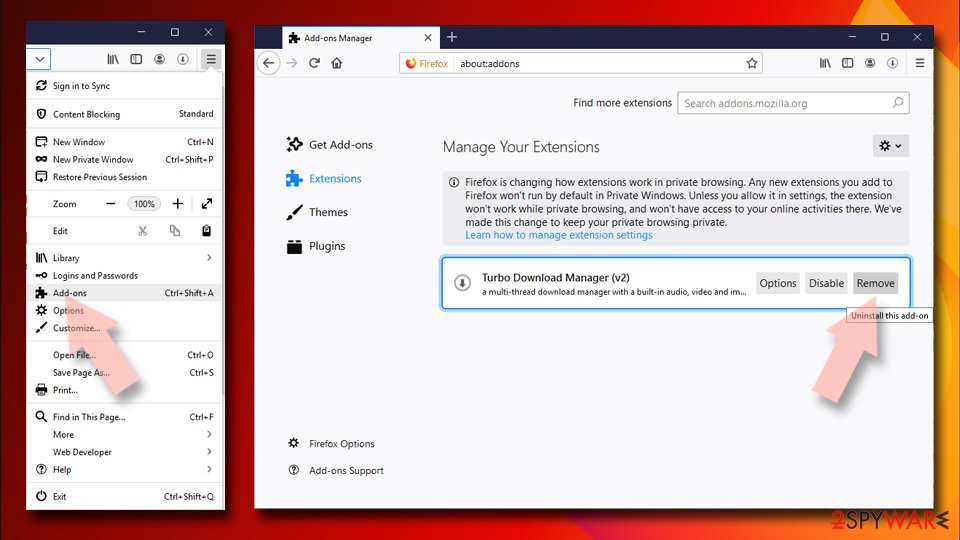
Reset the homepage:
- Click three horizontal lines at the top right corner to open the menu.
- Choose Options.
- Under Home options, enter your preferred site that will open every time you newly open the Mozilla Firefox.
Clear cookies and site data:
- Click Menu and pick Settings.
- Go to Privacy & Security section.
- Scroll down to locate Cookies and Site Data.
- Click on Clear Data…
- Select Cookies and Site Data, as well as Cached Web Content and press Clear.
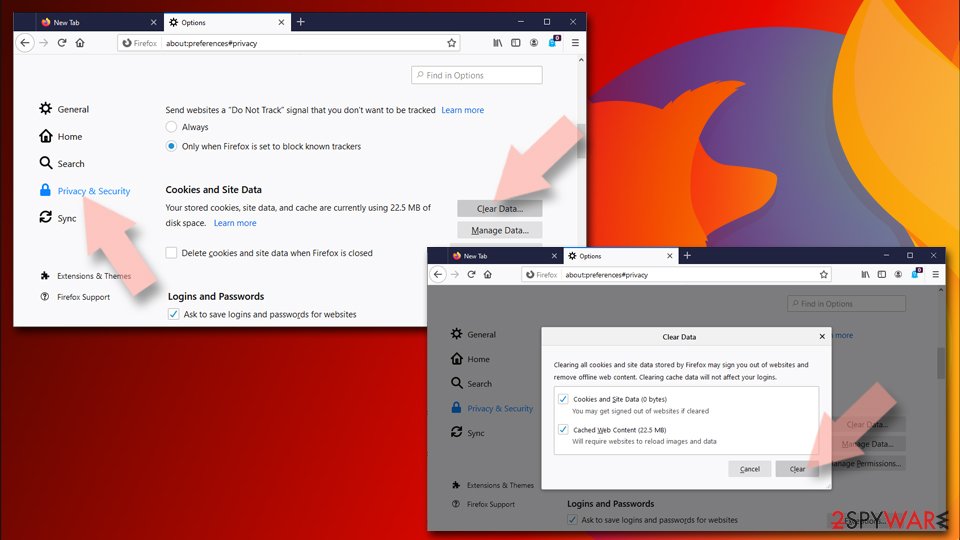
Reset Mozilla Firefox
If clearing the browser as explained above did not help, reset Mozilla Firefox:
- Open Mozilla Firefox browser and click the Menu.
- Go to Help and then choose Troubleshooting Information.
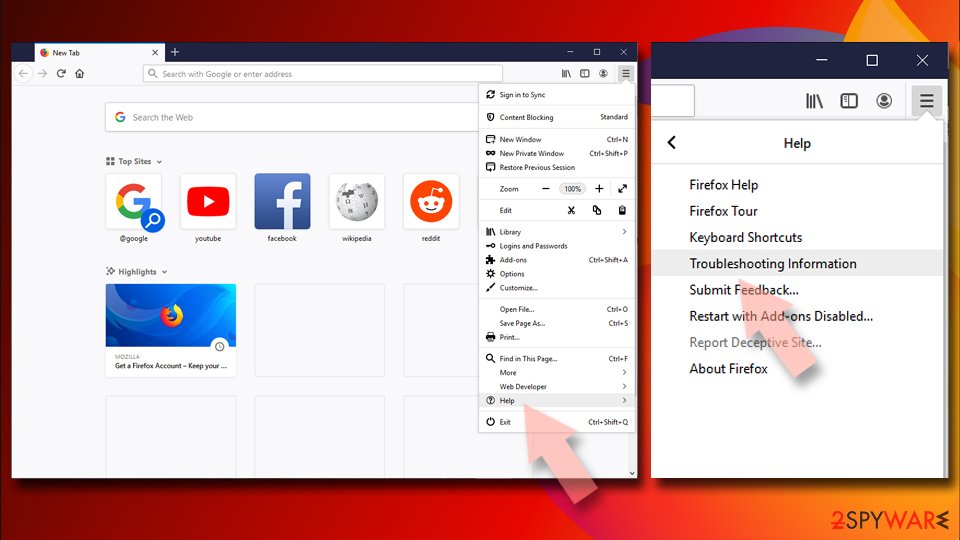
- Under Give Firefox a tune up section, click on Refresh Firefox…
- Once the pop-up shows up, confirm the action by pressing on Refresh Firefox.
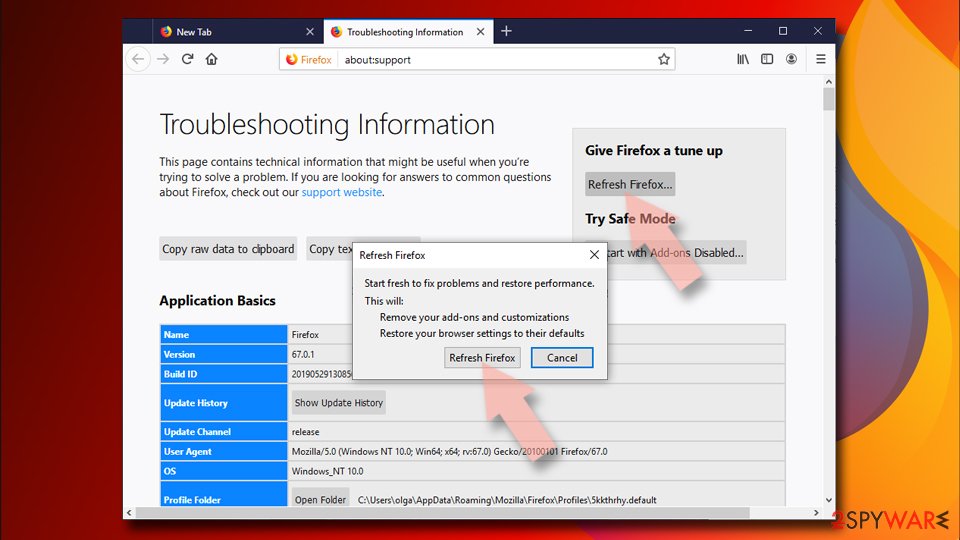
Remove from Google Chrome
If the potentially unwanted program has left any rogue components in your Google Chrome web browser, you can terminate all suspicious browser add-ons by using this guide:
Delete malicious extensions from Google Chrome:
- Open Google Chrome, click on the Menu (three vertical dots at the top-right corner) and select More tools > Extensions.
- In the newly opened window, you will see all the installed extensions. Uninstall all the suspicious plugins that might be related to the unwanted program by clicking Remove.
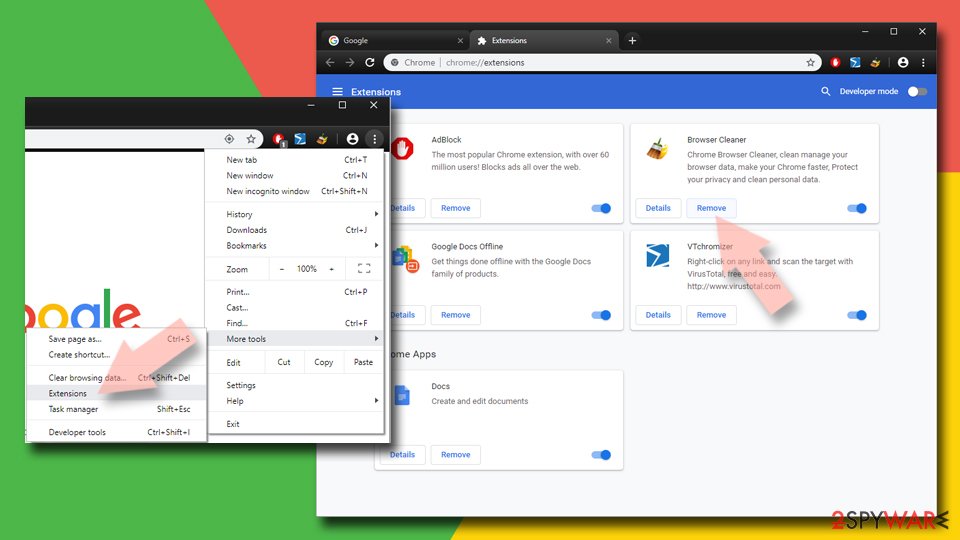
Clear cache and web data from Chrome:
- Click on Menu and pick Settings.
- Under Privacy and security, select Clear browsing data.
- Select Browsing history, Cookies and other site data, as well as Cached images and files.
- Click Clear data.
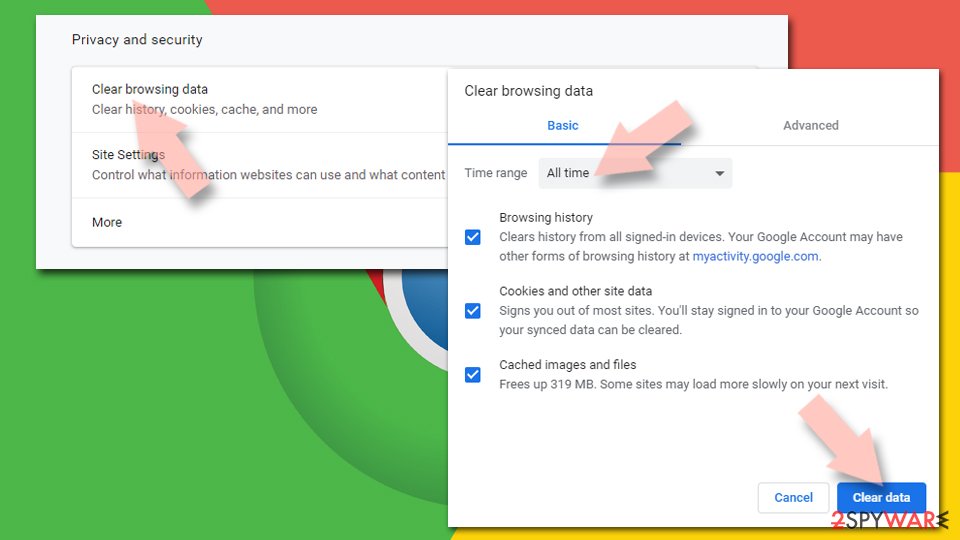
Change your homepage:
- Click menu and choose Settings.
- Look for a suspicious site in the On startup section.
- Click on Open a specific or set of pages and click on three dots to find the Remove option.
Reset Google Chrome:
If the previous methods did not help you, reset Google Chrome to eliminate all the unwanted components:
- Click on Menu and select Settings.
- In the Settings, scroll down and click Advanced.
- Scroll down and locate Reset and clean up section.
- Now click Restore settings to their original defaults.
- Confirm with Reset settings.
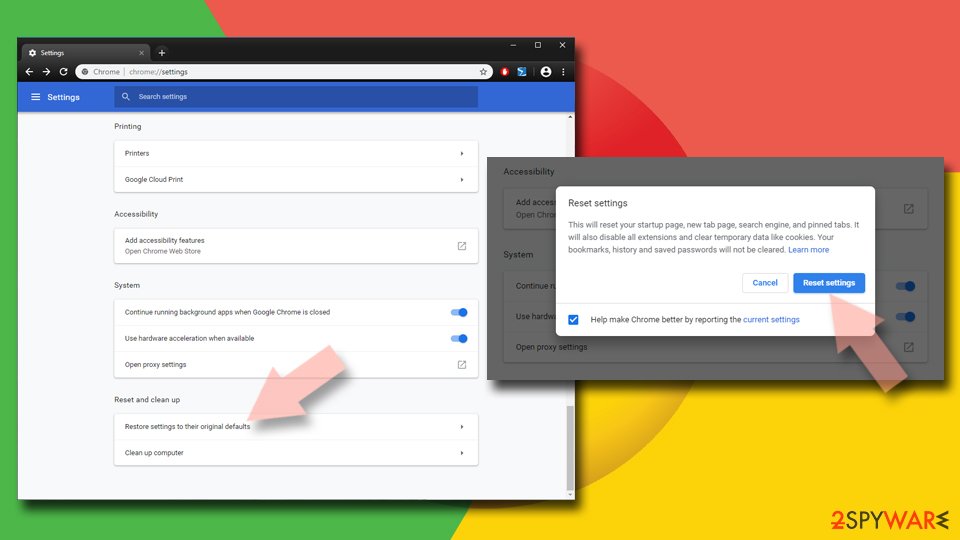
Delete from Safari
Remove unwanted extensions from Safari:
- Click Safari > Preferences…
- In the new window, pick Extensions.
- Select the unwanted extension and select Uninstall.
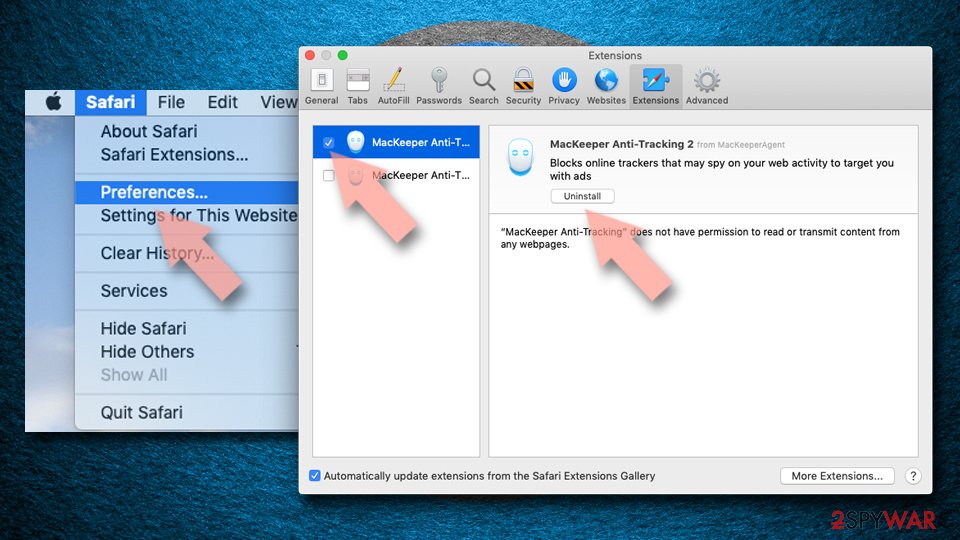
Clear cookies and other website data from Safari:
- Click Safari > Clear History…
- From the drop-down menu under Clear, pick all history.
- Confirm with Clear History.
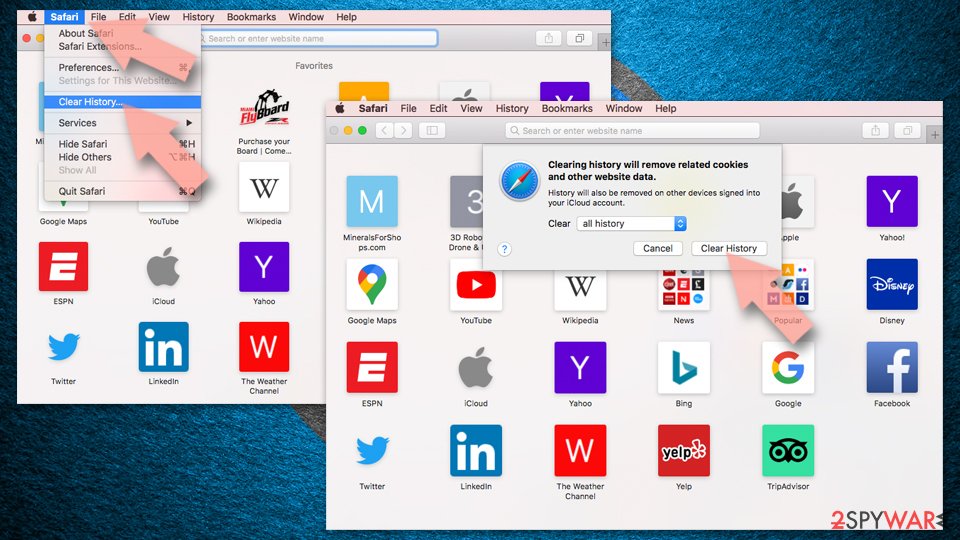
Reset Safari if the above-mentioned steps did not help you:
- Click Safari > Preferences…
- Go to Advanced tab.
- Tick the Show Develop menu in menu bar.
- From the menu bar, click Develop, and then select Empty Caches.
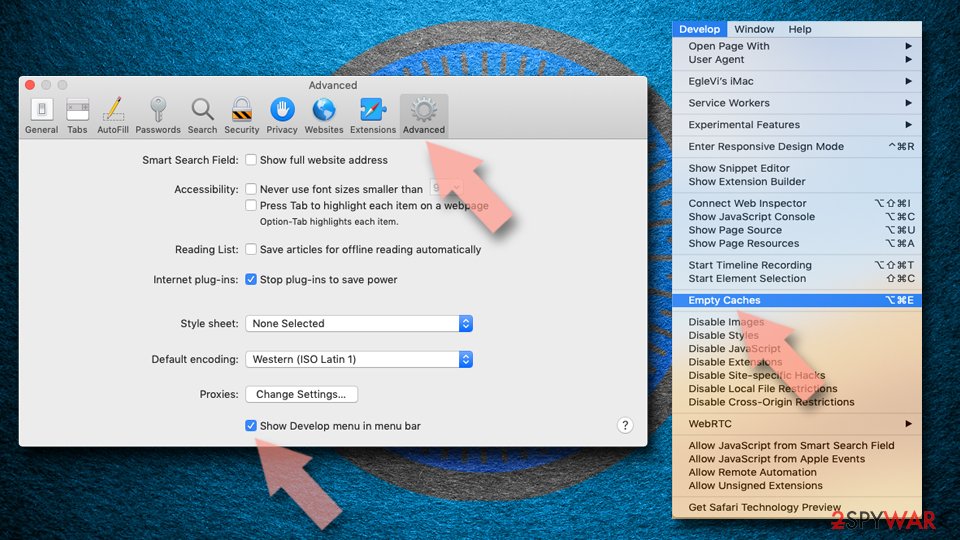
After uninstalling this potentially unwanted program (PUP) and fixing each of your web browsers, we recommend you to scan your PC system with a reputable anti-spyware. This will help you to get rid of Auto Mac Speedup registry traces and will also identify related parasites or possible malware infections on your computer. For that you can use our top-rated malware remover: FortectIntego, SpyHunter 5Combo Cleaner or Malwarebytes.
How to prevent from getting mac viruses
Access your website securely from any location
When you work on the domain, site, blog, or different project that requires constant management, content creation, or coding, you may need to connect to the server and content management service more often. The best solution for creating a tighter network could be a dedicated/fixed IP address.
If you make your IP address static and set to your device, you can connect to the CMS from any location and do not create any additional issues for the server or network manager that needs to monitor connections and activities. VPN software providers like Private Internet Access can help you with such settings and offer the option to control the online reputation and manage projects easily from any part of the world.
Recover files after data-affecting malware attacks
While much of the data can be accidentally deleted due to various reasons, malware is one of the main culprits that can cause loss of pictures, documents, videos, and other important files. More serious malware infections lead to significant data loss when your documents, system files, and images get encrypted. In particular, ransomware is is a type of malware that focuses on such functions, so your files become useless without an ability to access them.
Even though there is little to no possibility to recover after file-locking threats, some applications have features for data recovery in the system. In some cases, Data Recovery Pro can also help to recover at least some portion of your data after data-locking virus infection or general cyber infection.
- ^ Tim Fisher. What Is a Registry Key?. Lifewire.com. Independent news website.
- ^ Scareware. Wikipedia. The free encyclopedia.
- ^ SemVirus.pt. SemVirus.pt. Spyware news web page.
- ^ Chris Hoffman. PUPs Explained: What is a “Potentially Unwanted Program”?. How To Geek.
